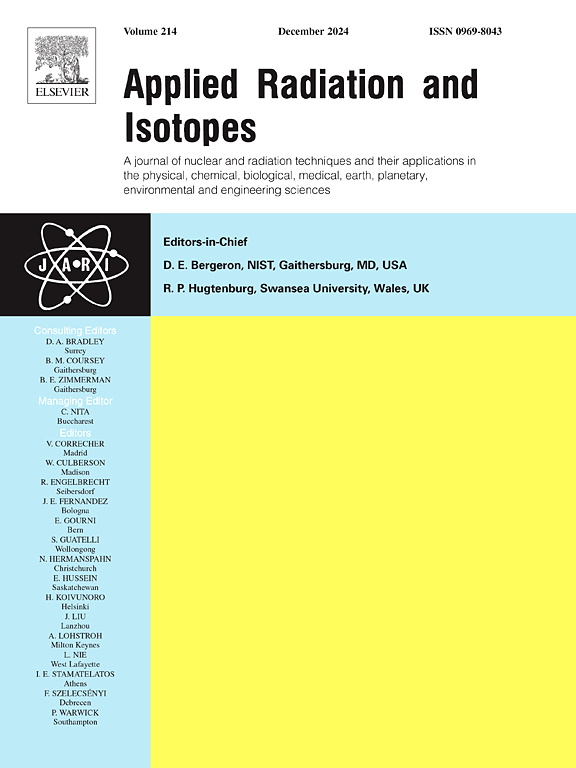Correlational study of naturally occurring radionuclides with radon and thoron exhalation rates in Pithoragarh district of central Himalayas
IF 1.6
3区 工程技术
Q3 CHEMISTRY, INORGANIC & NUCLEAR
引用次数: 0
Abstract
This study examines radon and thoron emissions from soil samples in Pithoragarh, Uttarakhand, and their correlation with naturally occurring radionuclides (226Ra, 232Th, and 40K) in locally used construction materials. Radiological hazard parameters, including radium equivalent activity (Raeq), hazard indices (Hin, Hex), absorbed gamma dose rates (Dout), and annual effective dose equivalents (AEDEout), were analyzed. Average activity concentrations were 66 ± 11 Bq/kg (226Ra), 43 ± 8 Bq/kg (232Th), and 602 ± 77 Bq/kg (40K), showing variability attributed to geological heterogeneity. Radon and thoron exhalation rates highlighted localized hotspots, with Raeq averaging 173 ± 81 Bq/kg and hazard indices mostly below safety limits but with significant deviations. Correlation analysis revealed strong relationships, such as between 226Ra and 232Th, suggesting shared origins, while other parameters reflected diverse environmental influences. These findings emphasize the importance of continuous monitoring, targeted mitigation, and regulatory strategies to manage potential radiological risks and provide a baseline for future regional studies.
喜马拉雅中部Pithoragarh地区自然发生的放射性核素与氡和钍呼出率的相关性研究
本研究检查了北阿坎德邦Pithoragarh土壤样品中的氡和钍排放,以及它们与当地使用的建筑材料中天然存在的放射性核素(226Ra、232Th和40K)的相关性。分析辐射危害参数,包括镭当量活度(Raeq)、危害指数(Hin、Hex)、吸收γ剂量率(Dout)和年有效剂量当量(AEDEout)。平均活度浓度分别为66±11 Bq/kg (226Ra)、43±8 Bq/kg (232Th)和602±77 Bq/kg (40K),表现出地质异质性的差异。氡和钍的呼出率突出了局部热点,平均Raeq为173±81 Bq/kg,危害指数大多低于安全限值,但存在显著偏差。相关分析显示,226Ra和232Th之间存在很强的关系,表明它们有共同的起源,而其他参数则反映了不同的环境影响。这些发现强调了持续监测、有针对性的缓解和管理战略对管理潜在辐射风险的重要性,并为未来的区域研究提供了基线。
本文章由计算机程序翻译,如有差异,请以英文原文为准。
求助全文
约1分钟内获得全文
求助全文
来源期刊

Applied Radiation and Isotopes
工程技术-核科学技术
CiteScore
3.00
自引率
12.50%
发文量
406
审稿时长
13.5 months
期刊介绍:
Applied Radiation and Isotopes provides a high quality medium for the publication of substantial, original and scientific and technological papers on the development and peaceful application of nuclear, radiation and radionuclide techniques in chemistry, physics, biochemistry, biology, medicine, security, engineering and in the earth, planetary and environmental sciences, all including dosimetry. Nuclear techniques are defined in the broadest sense and both experimental and theoretical papers are welcome. They include the development and use of α- and β-particles, X-rays and γ-rays, neutrons and other nuclear particles and radiations from all sources, including radionuclides, synchrotron sources, cyclotrons and reactors and from the natural environment.
The journal aims to publish papers with significance to an international audience, containing substantial novelty and scientific impact. The Editors reserve the rights to reject, with or without external review, papers that do not meet these criteria.
Papers dealing with radiation processing, i.e., where radiation is used to bring about a biological, chemical or physical change in a material, should be directed to our sister journal Radiation Physics and Chemistry.
 求助内容:
求助内容: 应助结果提醒方式:
应助结果提醒方式:


